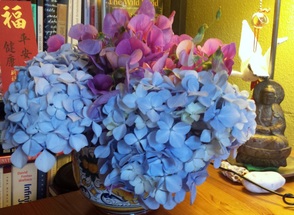 Yesterday I went for a walk in my neighborhood. Not my usual walk. I wanted to check out a fig tree that looked from a distance to be full with fruit. My neighborhood used to be, back in the early twentieth century, filled with fruit tree orchards, and some fruit trees still survive “in the wild”—poking out on the edges of cultivated private property, parks, trails, and along major streets. So with this task in mind, I found myself exploring the back country of one of the public garden parks, and then along, but just off, the Chief Sealth trail. Usually I stick to the main street sidewalk and the trail. With a different goal in mind, I started wandering. Though I didn’t find what I was looking for (the tree turned out not to be a fig), I was surprised by what I learned about where I live. And I’ve been here for ten years! There is the stream-carved gully that is paved over at one point by a major thoroughfare. I found several spots where various species of wildflowers and forgotten cultivars are blooming (wild pea vine flowers, which are everywhere right now, an ancient hydrangea and rose bush, different varieties of ferns, delphinia, and others…), and a small DIY farm in a neighbor’s side yard with chickens. Off the Sealth trail, I found a row of blackberry bushes bursting with bounty, some of which I sampled. They’re in a good place where I know they don’t spray and they aren’t exposed to car exhaust. I also came across some interesting poop. Not canine, hopefully not human. Who or what’s been there? Returning home I noticed that my perspective on where I live had changed. It almost seemed like a different place than the one I’ve known for so long. My mind and heart felt oddly more expansive with the new perspective gained simply from getting off the main street and trail and trekking along the edges. That edge between the urban wild and the municipally cultivated. And it wasn't just my perspective on where I lived that changed, but the perspective on where I was. And this shift in perspective stayed with me. I spent the rest of the day marveling at things normally mundane and habitual. That is an example of how Ecotherapy works.  Ecotherapy takes advantage of the wisdom gained from our first teacher and guide: Nature. Focusing attention and the senses upon the natural world, as opposed to the one built primarily by humans, can have a powerfully transformative and healing effect on our thinking and feeling, and especially on the sense of relationship with others, ourselves, and the world around us. Ecotherapy has evolved directly out of the need for deeper connection that the industrialized and high-tech world we live in has created. More plugged in than ever, we are also more disconnected and alienated than ever from others and the direct experience of our world. In the therapeutic relationship, ecotherapy involves enlisting the natural world as a partner. It also involves giving “homework” that helps the client experience first- hand the deepening of their relationship with nature and its profound effects. The therapist helps facilitate and process the meaning of whatever arises for the client in this context. But I’ll tell you a secret. You can also do your own ecotherapy. And, the best part is that it’s FREE! Here’s a practice to try: Take a walk in your neighborhood alone. Leave your cell phone at home, too. Find as many “wild” (not owned or cultivated on any private or municipal property) fruit trees or bushes as you can. Look for wildflowers or forgotten cultivars. Sample or cut if it seems safe/legal and bring your bounty back home. Notice what kind of thoughts and feelings come up for you along the way. It may sound too simple, but as the Ecophilosopher Arne Naess says of such practices: Simple in means, rich in ends.
|
AuthorElizabeth Sikes, Ph.D., LMHC Archives
March 2020
Categories
All
|
3136 E Madison st, Suite 300 S, Seattle, Wa 98112
iNTERCONNECTEDCOUNSELING [at] GMAIL [dot] COM
Copyright © 2016
 RSS Feed
RSS Feed